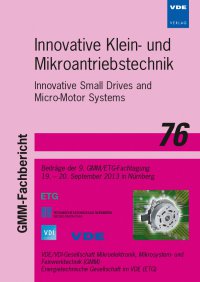Multi-Criteria Comparison of External and Dual-Rotor PMSM Topologies with Non-Overlapping Windings
Konferenz: Innovative Small Drives and Micro-Motor Systems - 9. GMM/ETG-Fachtagung
19.09.2013 - 20.09.2013 in Nürnberg, Deutschland
Tagungsband: Innovative Small Drives and Micro-Motor Systems
Seiten: 6Sprache: EnglischTyp: PDF
Persönliche VDE-Mitglieder erhalten auf diesen Artikel 10% Rabatt
Autoren:
Baun, Martin; Krotsch, Jens (ebm-papst Mulfingen GmbH & Co. KG, Mulfingen, Germany)
Ulm, Juergen (Heilbronn University, Campus Künzelsau, Künzelsau, Germany)
Piepenbreier, Bernhard (University of Erlangen-Nuremberg, Erlangen, Germany)
Inhalt:
Fractional horsepower permanent magnet synchronous motors with external rotors are favorably applied as direct drives for fans. In this field of application, the more important concern is the torque per costs ratio (TPCR) rather than the torque per volume ratio (TPVR). Therefore, high utilization of the materials is a major objective. Inactive parts can be used, combining an inner and an outer rotor design, which results in a two air-gap machine. In this work, the main characteristics and the general potential of such dual-rotor motors are developed and discussed. There are additional degrees of freedom compared to single-rotor motors, which can be used for design improvements. An approach to reluctant torque generation with a surface-mounted permanent magnet rotor is presented. Pareto-optimum designs of dual-rotor machines are compared to the conventional external rotor type regarding relevant design goals. As the magnetically induced vibrations are a serious issue in this field of application, the torque fluctuation is considered in addition. As a result, with the underlying assumptions, a significant improvement of the TPVR can be expected with dual-rotor motors, but no increase of the TPCR. Torque fluctuation and TPCR show an opposite behavior. Numerical results are verified by experiments with an dual-rotor motor prototype with a good correspondence.


